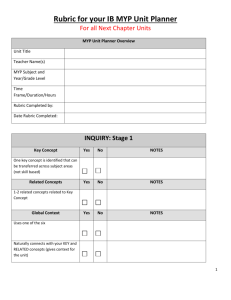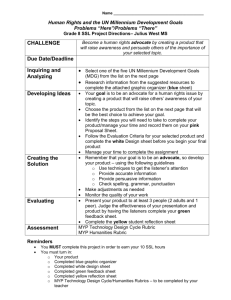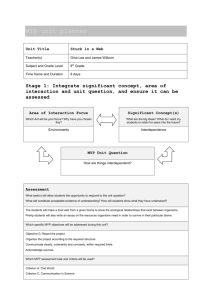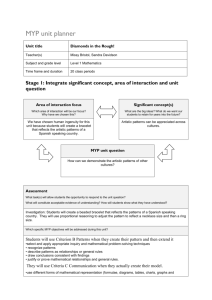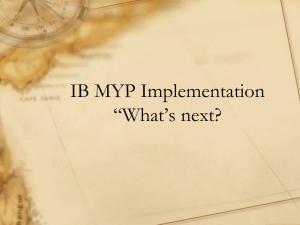FOR OFFICIAL USE ONLY SENATE ARMED SERVICES COMMITTEE
advertisement
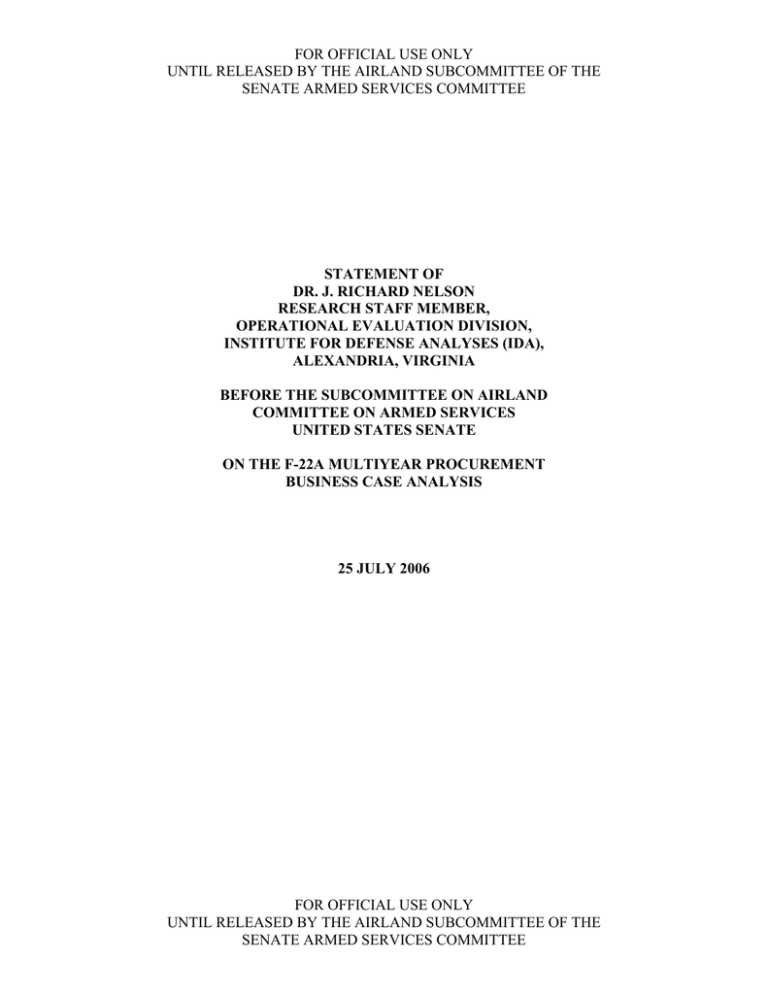
FOR OFFICIAL USE ONLY UNTIL RELEASED BY THE AIRLAND SUBCOMMITTEE OF THE SENATE ARMED SERVICES COMMITTEE STATEMENT OF DR. J. RICHARD NELSON RESEARCH STAFF MEMBER, OPERATIONAL EVALUATION DIVISION, INSTITUTE FOR DEFENSE ANALYSES (IDA), ALEXANDRIA, VIRGINIA BEFORE THE SUBCOMMITTEE ON AIRLAND COMMITTEE ON ARMED SERVICES UNITED STATES SENATE ON THE F-22A MULTIYEAR PROCUREMENT BUSINESS CASE ANALYSIS 25 JULY 2006 FOR OFFICIAL USE ONLY UNTIL RELEASED BY THE AIRLAND SUBCOMMITTEE OF THE SENATE ARMED SERVICES COMMITTEE FOR OFFICIAL USE ONLY UNTIL RELEASED BY THE AIRLAND SUBCOMMITTEE OF THE SENATE ARMED SERVICES COMMITTEE Mr. Chairman and Members of the Subcommittee, I am pleased to come before you today to discuss IDA’s work regarding the recently completed F-22A Multiyear Procurement (MYP) Business Case Analysis (BCA).1 My testimony today will be based on IDA Paper P-4116, copies of which have been provided previously. TASK OBJECTIVE AND APPROACH In January 2006, the Institute for Defense Analyses (IDA) was asked by the Office of the Under Secretary of Defense Acquisition Technology and Logistics to conduct a Business Case Analysis for a possible F-22A Multiyear Procurement. IDA’s task was to estimate the cost savings to the Government of pursuing an MYP contract for the three final planned lots of the F-22A program. An MYP contract was compared to three Single-Year Procurement (SYP) contracts. The study team first updated IDA’s existing F-22 cost model. This model, which IDA developed for its 2005 Independent Cost Estimate (ICE) for the F/A-22,2 was updated to reflect recent production experience and other new information. We then used the updated cost model to analyze the procurement strategies under constrained and unconstrained budgets under four scenarios, as outlined in Table 1. All scenarios involved the purchase of aircraft in the last three lots of production, Lots 7, 8, and 9. Table 1. Scenarios Addressed in Study Scenario 1 2 3 4a 4b SYP/MYP SYP MYP SYP MYP MYP Lot Number (Number of Units) 7 (20), 8 (20), 9 (20) 7 (20), 8 (20), 9 (20) 7 (20), 8 (20), 9 (16) 7 (20), 8 (20), 9 (16) 7 (20), 8 (20), 9 (18) Budget Constrained? No No Yes Yes Yes For Scenarios 1 and 2, the unconstrained cases, IDA estimated the costs of building 60 aircraft over the three lots regardless of whether the Defense Department’s current budgetary limits on the F-22A program would permit the Air Force to do so. Comparing these two scenarios is the best way to examine the impact of MYP on the purchase of 60 aircraft. For Scenarios 3 and 4, the constrained cases, IDA estimated the costs of the three-lot buy under budgetary limits established in the President’s Budget for FY 2007 (PB07). For Scenario 4b, IDA applied the MYP savings in 4a towards procuring additional aircraft in Lot 9. Scenarios 3, 1 IDA Paper P-4116, “F-22A Multiyear Procurement Business Case Analysis,” For Official Use Only, May 2006. 2 IDA Paper P-4029, “F/A-22 Independent Cost Estimate,” For Official Use Only, August 2005. 1 FOR OFFICIAL USE ONLY UNTIL RELEASED BY THE AIRLAND SUBCOMMITTEE OF THE SENATE ARMED SERVICES COMMITTEE FOR OFFICIAL USE ONLY UNTIL RELEASED BY THE AIRLAND SUBCOMMITTEE OF THE SENATE ARMED SERVICES COMMITTEE 4a, and 4b assume funding flows are adequate to support the lot sequence 20, 20, and x—where x is the incremental number of units in Lot 9 afforded under the cumulative PB07 budget authority. Note that the constraint we imposed is the total funding in PB07 for Lots 7, 8, and 9, and not its year-to-year funding levels. In Scenarios 3, 4a, and 4b the year-to-year funding levels would have to be shifted (within the PB07 total) to fully fund the SYP and the MYP. IDA used data provided by F-22A contractors and Government offices to estimate MYP savings. These data included information from previous F-22 MYP studies and recent MYP experience with other aircraft programs. In analyzing these data we took into account differences between the currently proposed F-22A MYP and MYP programs in the historical database. For example, our estimate recognizes that the F-22 MYP would include fewer lots and aircraft units than previous fighter aircraft MYPs. IDA also had in-depth discussions with suppliers who were expected to be a source of savings under the MYP strategy. From these data and analyses, IDA developed percentage reductions in the cost elements in the model that would benefit from cost savings in an MYP. The sum of these reductions constitute our estimate of the savings provided by the MYP. The cost estimating approach we used was otherwise identical to that used for IDA’s F/A-22 ICE, copies of which were provided to the Congress in August 2005. SUMMARY OF RESULTS IDA estimated the savings with MYP to be 2.2 percent of procurement costs. We estimated the savings for the air vehicle contract (Lockheed Martin Aeronautics and Boeing) to be 2.6 percent for both the constrained and unconstrained cases. Savings for the engine contract (Pratt & Whitney) were estimated to be 2.7 percent, also for both cases. The percentage savings on total procurement are lower than on contract costs because substantial portions of the procurement budget would not be part of the multiyear contracts. Table 2 summarizes the BCA results. In the unconstrained total budget cases, Scenarios 1 and 2, MYP results in the maximum savings since the maximum number of aircraft are procured. The $235 million in savings represent 2.2 percent of procurement cost for Lots 7–9. Constraining the buy to the total budget of record reduces the number of aircraft by 4 to 56 in the SYP Scenario 3. At 56 units (three lots of 20, 20, and 16 aircraft), the MYP strategy reduces the cost by the same 2.2 percent, but for a lower total savings of $225 million. If the $225 million in savings were applied instead towards additional aircraft, the Air Force would be able to buy 2 more units for a total of 58. The addition of two aircraft using $225 million in MYP savings may seem optimistic. Note, however, that IDA’s cost modeling approach takes into account fixed as well as variable costs, so the $225 million has to cover only the variable portion of aircraft costs. The fixed portion must be paid regardless of lot quantity. 2 FOR OFFICIAL USE ONLY UNTIL RELEASED BY THE AIRLAND SUBCOMMITTEE OF THE SENATE ARMED SERVICES COMMITTEE FOR OFFICIAL USE ONLY UNTIL RELEASED BY THE AIRLAND SUBCOMMITTEE OF THE SENATE ARMED SERVICES COMMITTEE Table 2. MYP BCA Results Summary (Then-Year $ Millions) Scenario 1–2 $10,863 $10,628 $235 2.2% No SYP Budget (Scenarios 1 and 3) MYP Budget (Scenarios 2, 4a, and 4b) MYP under/(over) SYP Savings Percentage of Procurement Constrained to Budget AUFC of Lots 7–9 Aircraft (SYP/MYP) AUPC of Lots 7–9 Aircraft (SYP/MYP) Aircraft in Lots 7–9 (SYP/MYP) Total Quantity, including Production, Production Representative Test Vehicles (PRTVs), and Replacement Test Aircraft (RTA) Scenario 3–4a Scenario 3–4b $10,438 $10,438 $10,213 $10,423 $225 $15 2.2% N/A Yes Yes $158/$154 $181/$177 60/60 $162/$158 $186/$182 56/56 $162/$156 $186/$180 56/58 182 178 180 That completes my description of IDA’s work on the F-22A MYP BCA. We provided this information to our sponsor to inform the Defense Department’s decision process. We were not asked for, nor did we provide, a recommendation on the decision itself. Our role was to estimate the cost savings with MYP. Mr. Chairman and Members of the Subcommittee, thank you for your attention. I am available for comments and questions. 3 FOR OFFICIAL USE ONLY UNTIL RELEASED BY THE AIRLAND SUBCOMMITTEE OF THE SENATE ARMED SERVICES COMMITTEE

